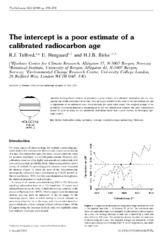| dc.contributor.author | Telford, Richard J. | eng |
| dc.contributor.author | Heegaard, Einar | eng |
| dc.contributor.author | Birks, Harry John Betteley | eng |
| dc.date.accessioned | 2004-07-30T09:54:49Z | |
| dc.date.accessioned | 2004-08-03T12:57:51Z | |
| dc.date.accessioned | 2004-08-26T11:58:44Z | |
| dc.date.available | 2004-07-30T09:54:49Z | |
| dc.date.available | 2004-08-03T12:57:51Z | |
| dc.date.available | 2004-08-26T11:58:44Z | |
| dc.date.issued | 2004 | eng |
| dc.Published | The Holocene 2004 14(2): 296–298 | en |
| dc.identifier.issn | 0959-6836 | en_US |
| dc.identifier.uri | https://hdl.handle.net/1956/414 | |
| dc.description.abstract | Intercept-based methods of generating a point estimate of a calibrated radiocarbon date are very popular, but exhibit undesirable behaviour. They are highly sensitive to the mean of the radiocarbon date and to adjustments of the calibration curve. Other methods give more stable results. The weighted average of the probability distribution function is recommended as the best central-point estimate, but more consideration should be given to using the full probability distribution rather than a point estimate in developing agedepth models. | en_US |
| dc.format.extent | 16780 bytes | eng |
| dc.format.extent | 134572 bytes | eng |
| dc.format.extent | 166 bytes | eng |
| dc.format.mimetype | text/plain | eng |
| dc.format.mimetype | application/pdf | eng |
| dc.format.mimetype | text/plain | eng |
| dc.language.iso | eng | eng |
| dc.publisher | Arnold Publishers | en_US |
| dc.subject | Radiocarbon dating | eng |
| dc.subject | Calibration | eng |
| dc.subject | Intercept | eng |
| dc.subject | Weighted average | eng |
| dc.subject | Holocene | eng |
| dc.subject | Methodology | eng |
| dc.title | The intercept is a poor estimate of a calibrated radiocarbon age | en_US |
| dc.type | Peer reviewed | |
| dc.type | Journal article | |
| dc.rights.holder | Copyright 2004 Arnold | en_US |
| dc.identifier.doi | https://doi.org/10.1191/0959683604hl707fa | |
